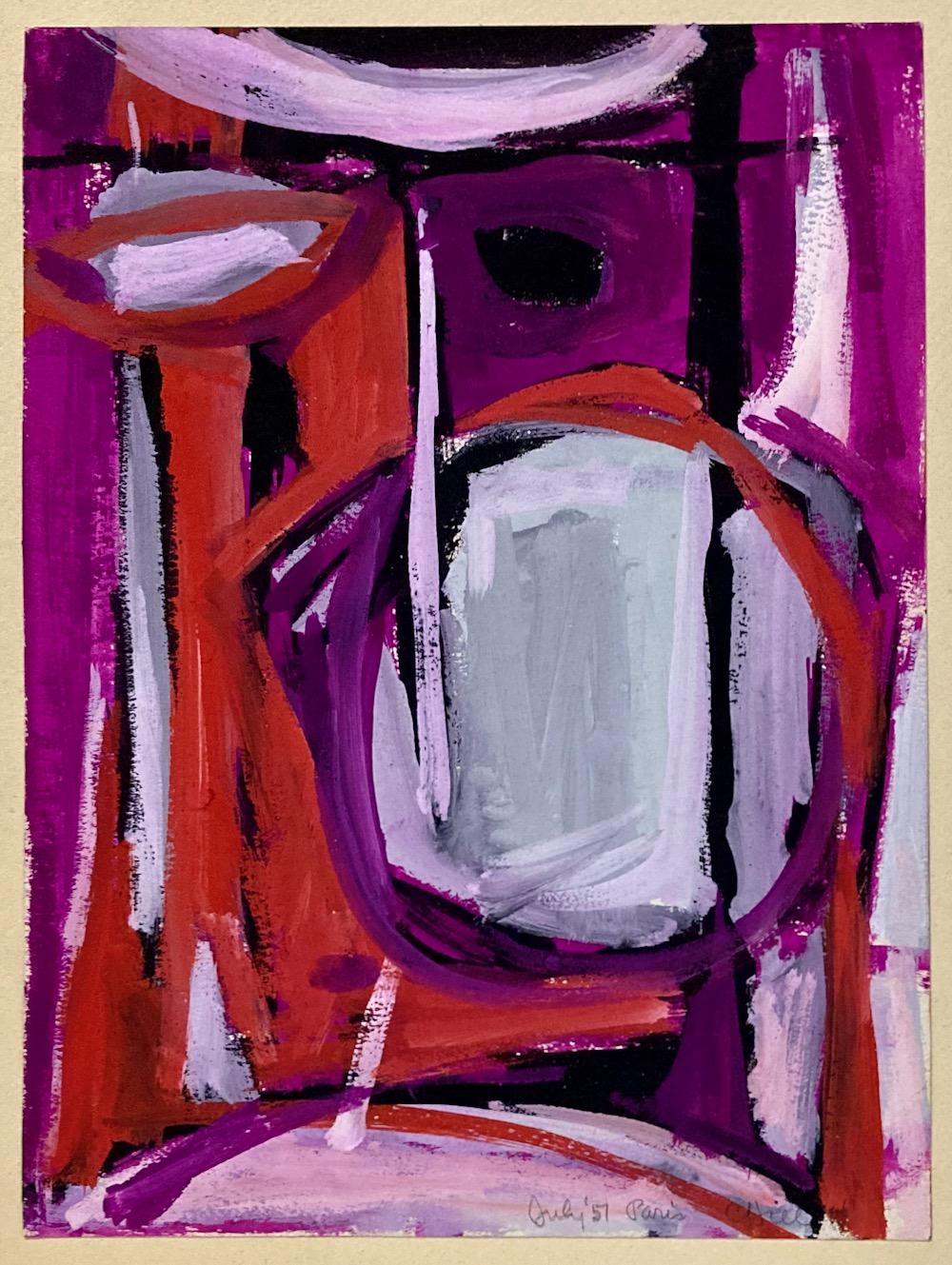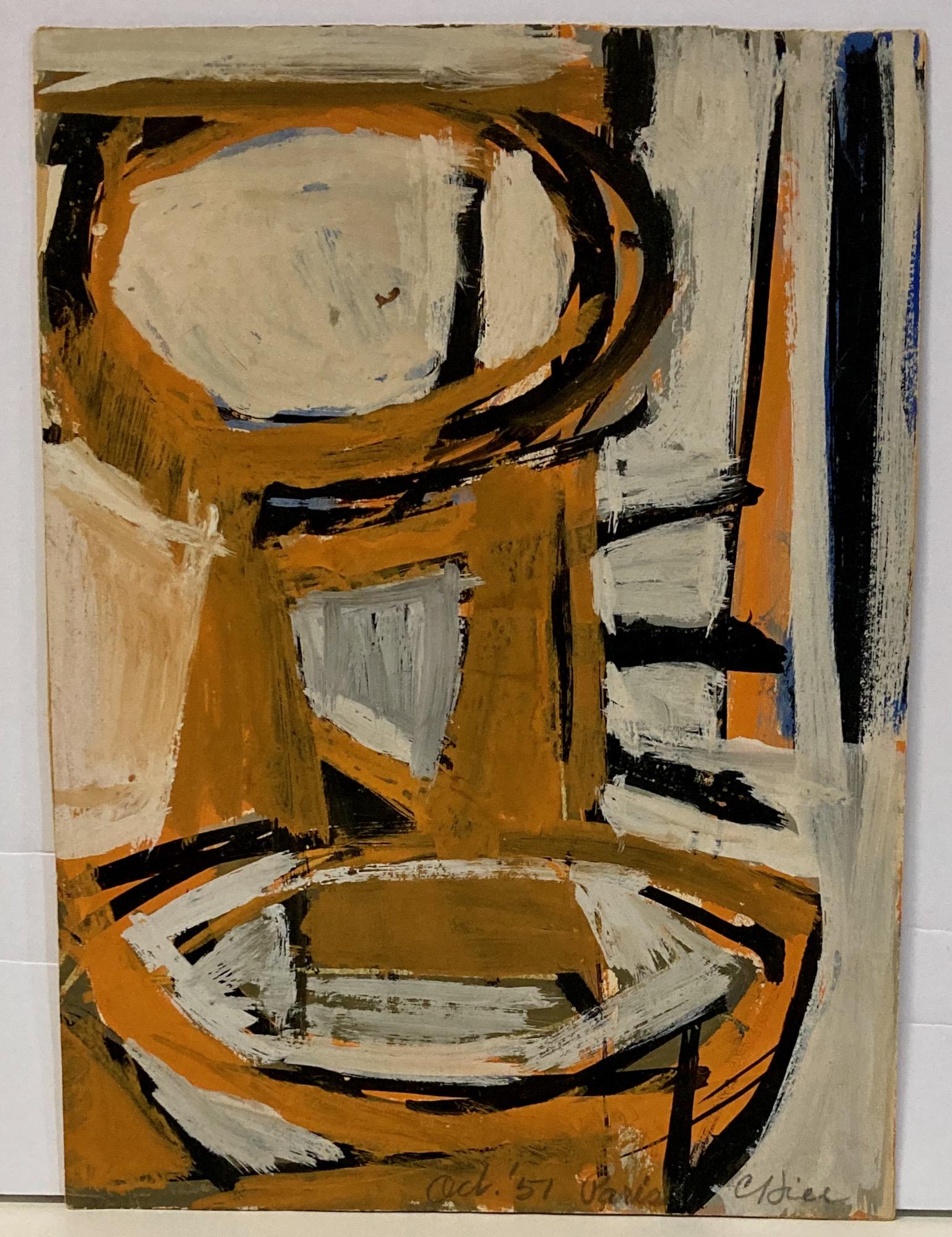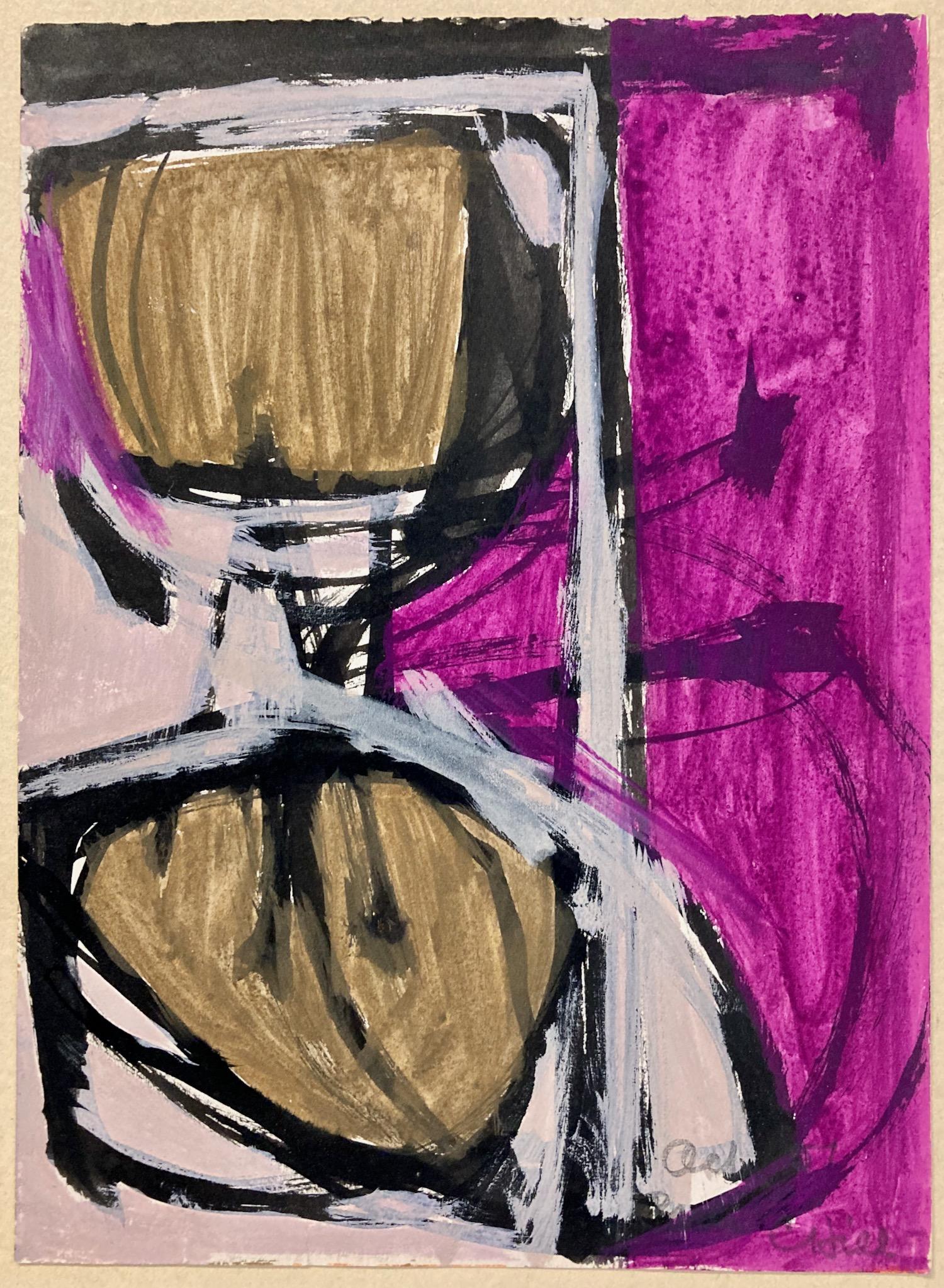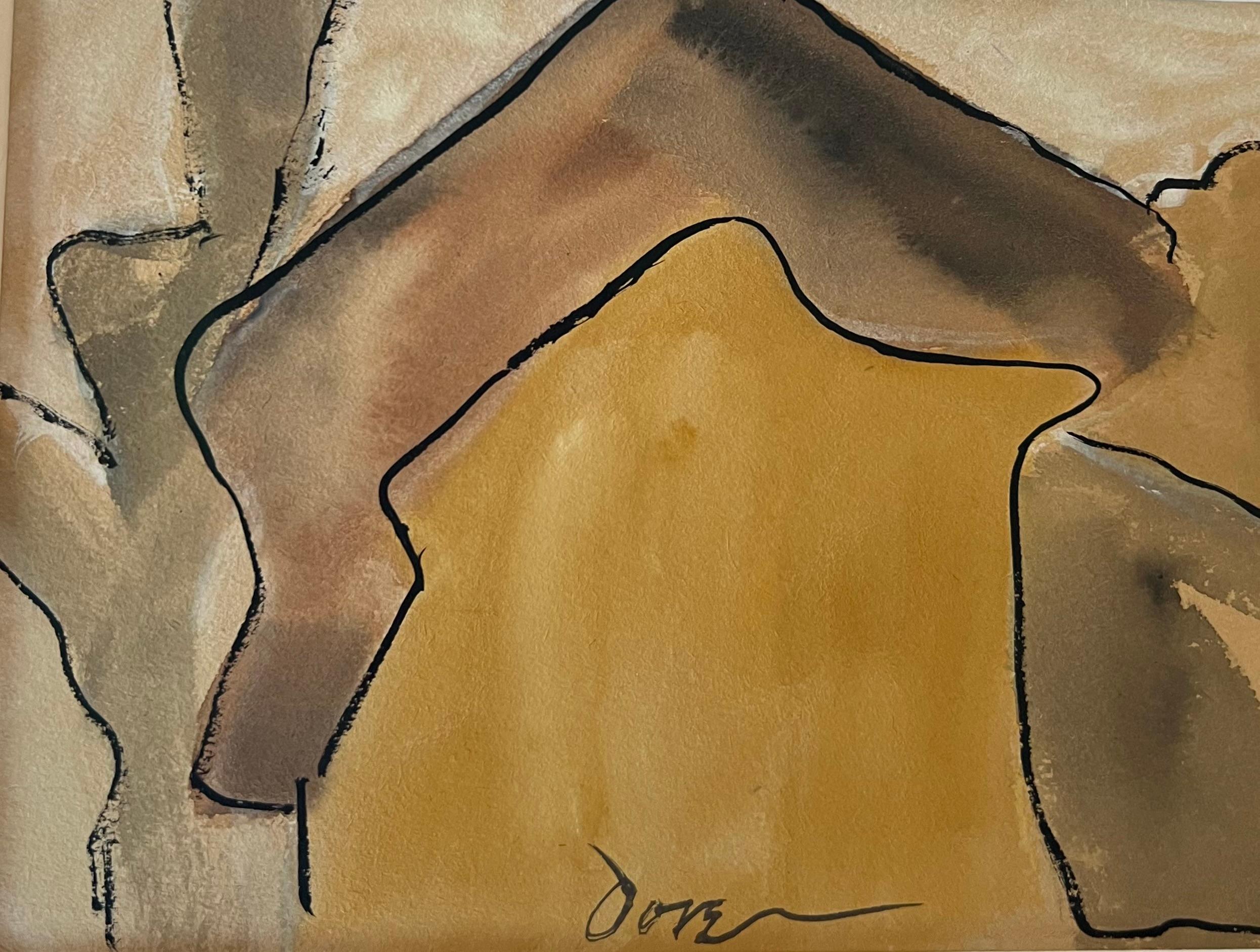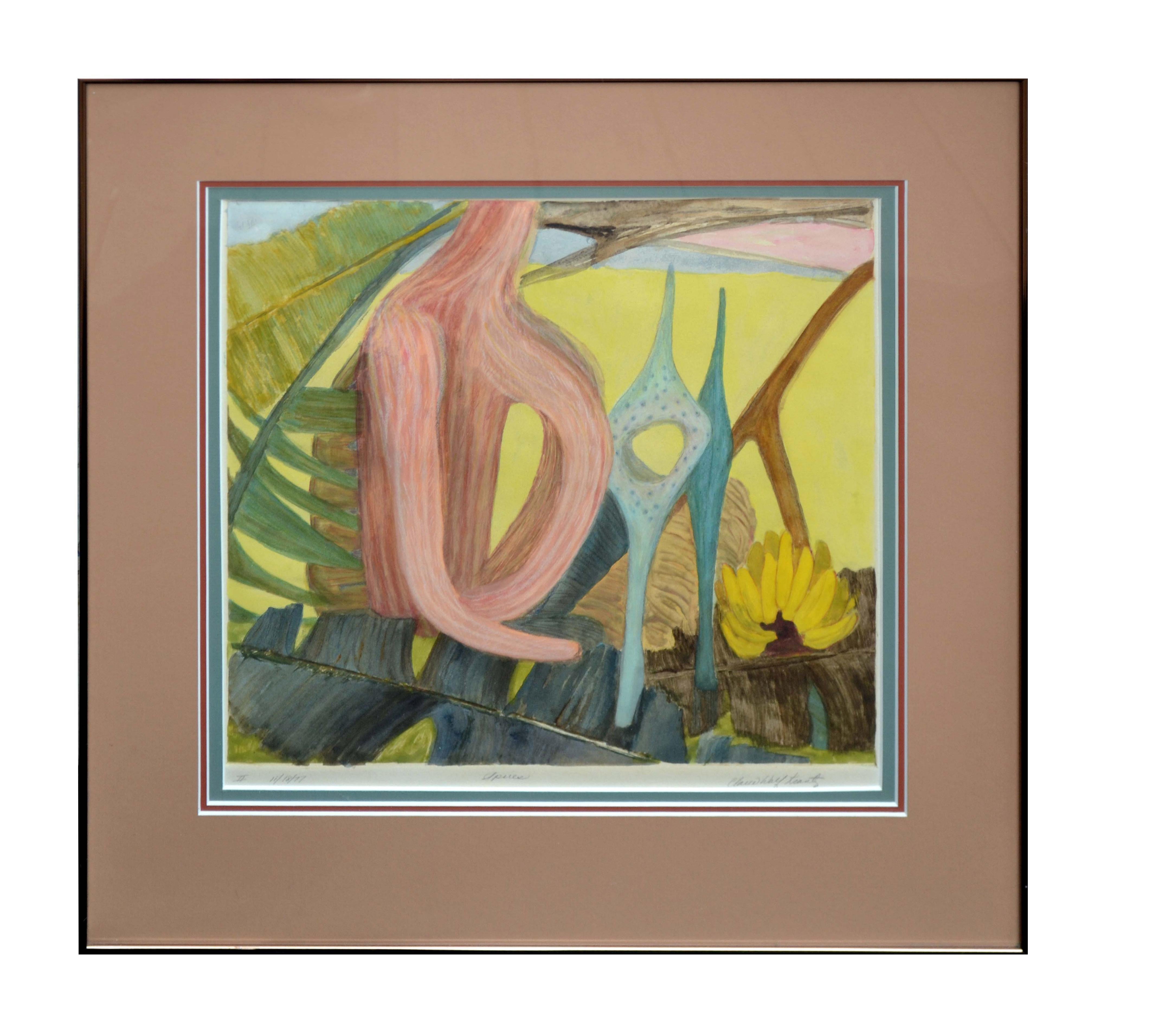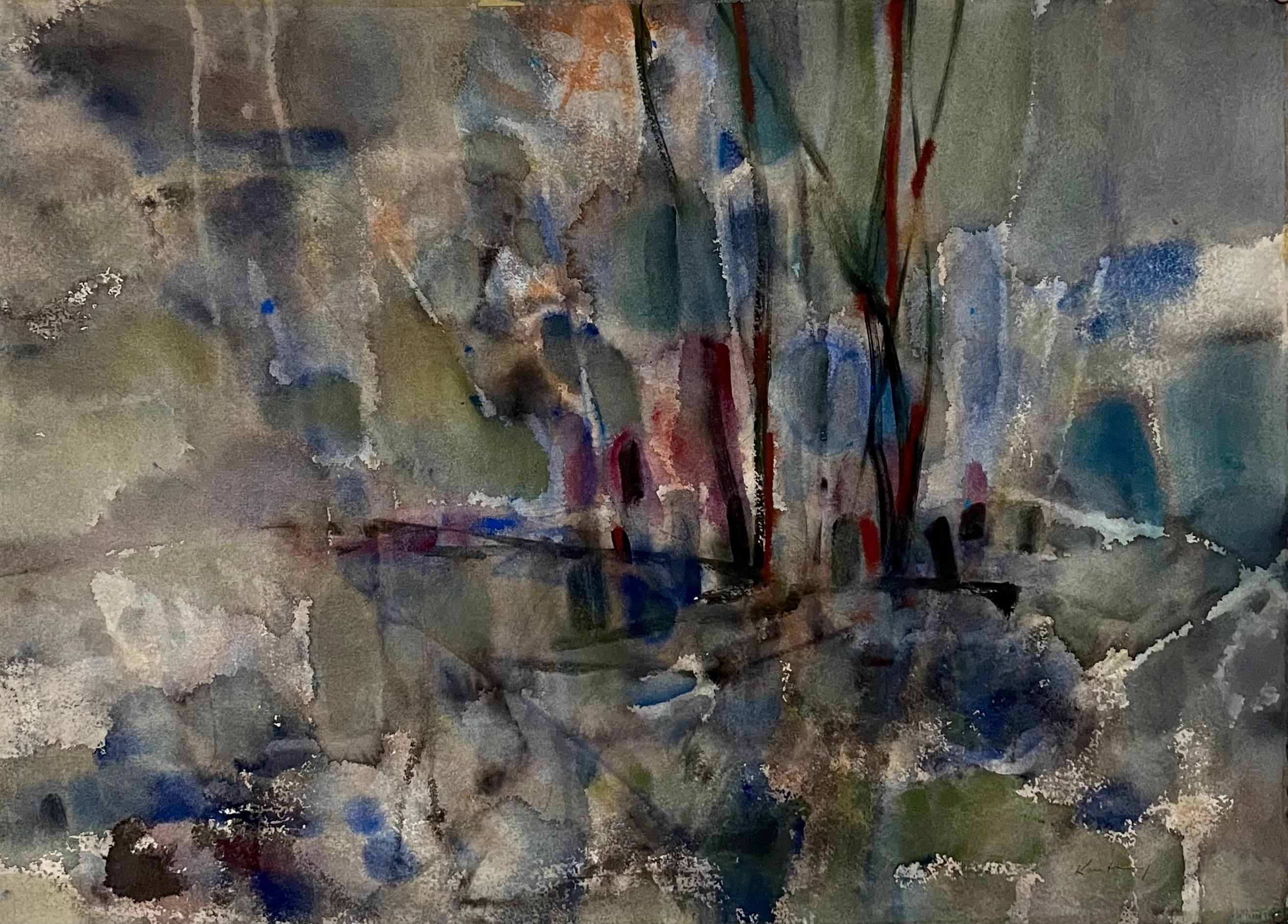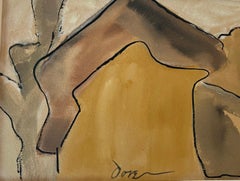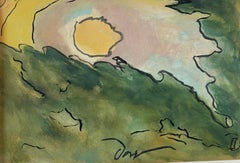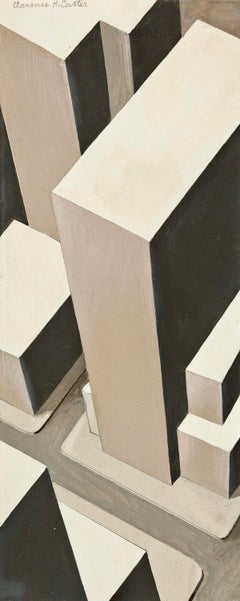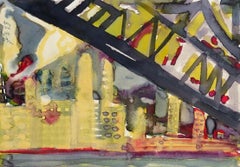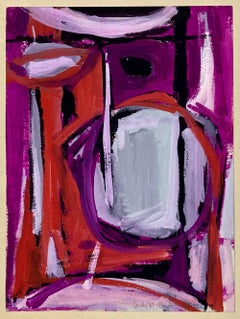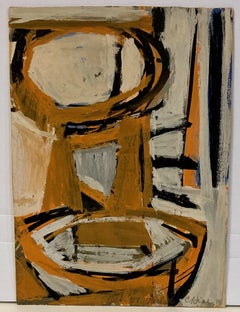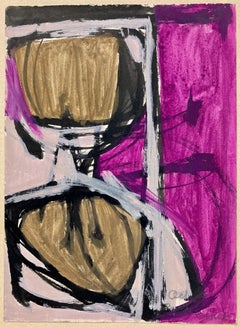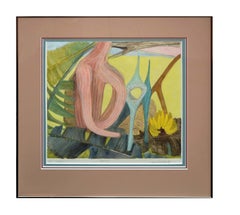Items Similar to "NY Street Signs" Mid-20th Century WPA 1938 Modernist Abstract Realism Pop Art
Want more images or videos?
Request additional images or videos from the seller
1 of 11
Stuart Davis"NY Street Signs" Mid-20th Century WPA 1938 Modernist Abstract Realism Pop Art1938
1938
About the Item
"NY Street Signs" Mid-20th Century WPA 1938 Modernist Abstract Realism Pop Art
Stuart Davis (American, 1892-1964) "Street Signs" Modernist gouache and traces of pencil on paper in the proto-pop art style Davis is celebrated for, 1938, signed to lower right, framed. Image: 11 1/4 x 15 1/4 inches. Frame by Bark: 18 1/2 x 22 inches.
LITERATURE: A, Boyajian, M. Rutkowski, Stuart Davis, A Catalogue Raisonne, Vol. 2, New Haven, Connecticut, 2007, vol. II, p. 632, no. 1232, illustrated.
EXHIBITIONS: ACA Galleries, New York American Artists' Congress: Group Exhibition of Paintings and Sculpture, Dec. 3-16, 1939 (SDAB I, 12/3/39, p. 129). Outlines Gallery, Pittsburgh, Stuart Davis, Mar. 3-16, 1946. Coleman Art Gallery, Philadelphia, 5 Prodigal Sons: Former Philadelphia Artists: Ralston Crawford, Stuart Davis, Charles Demuth, Julian Levi, Charles Sheeler, Oct 4 - 30, 1947 (pamphlet), no. 12.
PROVENANCE: The artist; Mr. and Mrs. Frank Bowles, New York, Apr. 3, 1956; thence by descent, Private Collection, New York.
NOTES: According to the Catalogue Raissonne, "the title 'Street Signs' is recorded in the artist's account books (SDAB I, 12/3/39, p. 129; SDAB III. No. 89, 4/3/56, pp. 252-253), and in the Downtown Gallery's ca. 1946-56 stocklists and 4/3/56 purchase slip. Davis documents the completion of this work in his calendar entry, SDC 6.5.38, where he refers to this gouache with the working title: 'N.Y. Street Signs.'"
BIO
Admired for his artistic independence, brilliant use of color, and wit, Stuart Davis is regarded as one of the finest interwar modernists. The son of artist parents who met as students at the Pennsylvania Academy of the Fine Arts, he found his place amid the currents of twentieth-century American art earlier than some of his peers. Among his first art-world mentors were the artists known as The Eight and, later, the Ashcan School. At the time of his son's birth, Davis's father, an art editor, employed some of these artists at the Philadelphia Press and the family connection endured over subsequent years.
As a teenager, Davis left high school in New Jersey for New York City, where he received formal art training from 1910 to 1913 at the school founded by Robert Henri, artistic father of The Eight. Although Henri worked in a realist vein, he rejected academic idealism and urged his students to observe and sketch city life as experienced on streets and in music halls, taverns, and other locations. Davis lived in Newark during his art studies; in the dive bars he frequented, he developed an abiding passion for the technical precision and expressive spontaneity of jazz.
With his contribution of five watercolors, Davis was among the youngest participants in the seminal Armory Show (International Exhibition of Modern Art) in 1913, organized by a group of artists in order to introduce Americans to new developments in art across the Atlantic and at home. Excited by the formal innovations and bold use of color displayed by the European modernists, particularly Matisse, van Gogh, and Gauguin, Davis dedicated the next several years to becoming a modern artist.
By the early 1920s, Davis had left behind the representational realism of his early career. No matter how abstract his work became—and the degree of abstraction varied throughout his career—he always considered himself an observer of the world around him. In 1951, he expressed regret "that I have long been 'type-cast' as 'Abstract' because my interest in Abstractions is practically zero."(1) Instead, he identified his paintings as "Color-Space Compositions," in which areas of color define spatial relationships. Davis applied his formal concepts to subject matter ranging from still lifes, to landscapes, to commercial imagery and other aspects of urban life.
Just as a jazz musician riffs on snippets borrowed from popular music or explores all the permutations of a single phrase, so Davis drew from a personal well of reference points, remaking them into new images. In 1942 he remarked in his notebook: "I can work from Nature, from old sketches and paintings of my own, from photographs, and from other works of art. In each case the process consists of transposition of the forms of the subject into a coherent, objective color-space continuum, which evokes a direct sensate response to structure."
During Davis's own lifetime, his work was the subject of retrospectives at The Museum of Modern Art, New York (1945) and the Walker Art Center, Minneapolis (1957), and included in a wide variety of group exhibitions focusing on modern or abstract art. Sometimes identified as a forerunner of the next generation's Pop artists, Davis shared their engagement with American mass culture, if not their tendency to treat fragments of everyday life to iconic status. Instead Davis turned the stuff—objects, imagery, and language—of modernity into grace notes within his vivid impressions of urban experience. Keenly aware of his position as both participant in and chronicler of his cultural moment, he noted, "An artist who has traveled on a steam train, driven an automobile, or flown in an airplane doesn't feel the same way about form and space as one who has not."
- Creator:Stuart Davis (1892-1964, American)
- Creation Year:1938
- Dimensions:Height: 18.5 in (46.99 cm)Width: 22 in (55.88 cm)Depth: 1 in (2.54 cm)
- Medium:
- Movement & Style:
- Period:
- Condition:
- Gallery Location:New York, NY
- Reference Number:1stDibs: LU1156213415932
About the Seller
5.0
Platinum Seller
Premium sellers with a 4.7+ rating and 24-hour response times
Established in 2008
1stDibs seller since 2019
189 sales on 1stDibs
Typical response time: <1 hour
- ShippingRetrieving quote...Shipping from: New York, NY
- Return Policy
Authenticity Guarantee
In the unlikely event there’s an issue with an item’s authenticity, contact us within 1 year for a full refund. DetailsMoney-Back Guarantee
If your item is not as described, is damaged in transit, or does not arrive, contact us within 7 days for a full refund. Details24-Hour Cancellation
You have a 24-hour grace period in which to reconsider your purchase, with no questions asked.Vetted Professional Sellers
Our world-class sellers must adhere to strict standards for service and quality, maintaining the integrity of our listings.Price-Match Guarantee
If you find that a seller listed the same item for a lower price elsewhere, we’ll match it.Trusted Global Delivery
Our best-in-class carrier network provides specialized shipping options worldwide, including custom delivery.More From This Seller
View All"Barns" Watercolor Mid-20th Century Modern Abstract Realism Excellent Provenance
By Arthur Dove
Located in New York, NY
"Barns" Watercolor Mid-20th Century Modern Abstract Realism Excellent Provenance
Arthur Dove (1880-1946)
"Barns"
5 x 7 inches
Watercolor on paper, 1940
Singed lower center
Framed: 9...
Category
1940s American Modern Abstract Drawings and Watercolors
Materials
Paper, Watercolor
"Through the Trees" Watercolor Mid-20th Century Modern Excellent Provenance
By Arthur Dove
Located in New York, NY
"Through the Trees" Watercolor Mid-20th Century Modern Excellent Provenance
Arthur Dove (1880-1946)
"Through the Trees"
5 x 7
Watercolor on paper, 1938
Singed lower center
Framed: 1...
Category
1930s American Modern Abstract Drawings and Watercolors
Materials
Paper, Watercolor
Abstract Cityscape Mid 20th Century Modern Cubist Work on Paper Drawing Ariel
By Clarence Holbrook Carter
Located in New York, NY
Abstract Cityscape Mid 20th Century Modern Cubist Work on Paper Drawing Ariel
11 x 4 1/2 inches. Framed by Heydenryk.
Provenance: Gary Snyder Fine Art
B...
Category
1950s Abstract Abstract Drawings and Watercolors
Materials
Paper, Gouache
Bridge Contemporary African American Urban Landscape 20th Century Alvin Ailey NY
By Romare Bearden
Located in New York, NY
"Bridge" Contemporary African American Urban Landscape 20th Century Alvin Ailey NYC
ROMARE BEARDEN (American, 1914-1988)
The Bridge, 1982
signed 'Romare Bearden' (upper left); with...
Category
1980s Contemporary Landscape Drawings and Watercolors
Materials
Paper, Watercolor
Abstract Landscape Mid 20th Century Work on Paper Hamptons, NY Drawing Pastel
By Robert Dash
Located in New York, NY
Abstract Landscape Mid 20th Century Work on Paper Hamptons, NY Drawing Pastel. Signed and dated '62 lower right. 9 x 12 inches (sight) and 15. 1/2 x 18 1/2 inches framed.
BIO
Robert Dash is known for his Hamptons paintings...
Category
1960s Abstract Abstract Drawings and Watercolors
Materials
Paper, Pastel
"Abstract Cityscape" NYC Early 20th Century American Scene Social Realism Ashcan
By Abraham Walkowitz
Located in New York, NY
"Abstract Cityscape" NYC Early 20th Century American Scene Social Realism Ashcan
Abraham Walkowitz (American, 1878-1965)
Abstract Cityscape
Sight: 6 1/4' x 8 1/2 inches
Mixed media...
Category
1910s Abstract Landscape Drawings and Watercolors
Materials
Paper, Mixed Media
You May Also Like
Clinton Hill, Paris, July, 1951 (France), mid-century abstract gouache drawing
By Clinton Hill
Located in New York, NY
Clinton Hill (1922-2003), created quintessential mid-century images.
He lived in SoHo, New York, and was a frequent Gallery visitor.
Born in Idaho and raised on a working ranch, ...
Category
Mid-20th Century American Modern Abstract Drawings and Watercolors
Materials
Gouache
Clinton Hill, Paris, Oct., 1951 (France), mid-century abstract gouache drawing
By Clinton Hill
Located in New York, NY
Clinton Hill (1922-2003), created quintessential mid-century images.
He lived in SoHo, New York, and was a frequent Gallery visitor.
Born in Idaho and raised on a working ranch, ...
Category
Mid-20th Century American Modern Abstract Drawings and Watercolors
Materials
Gouache
Clinton Hill, Paris, Oct., 1951 (France), mid-century abstract gouache drawing
By Clinton Hill
Located in New York, NY
Clinton Hill (1922-2003), created quintessential mid-century images.
He lived in SoHo, New York, and was a frequent Gallery visitor.
Born in Idaho and raised on a working ranch, ...
Category
Mid-20th Century American Modern Abstract Drawings and Watercolors
Materials
Gouache
Modern Tropical Abstract -- "Spires II"
Located in Soquel, CA
Colorful abstract watercolor of imaginative shapes in a tropical setting with botanical landscape elements by Claire Wolf Krantz (American, b. 1938). Signed "Claire Wolf Krantz" lower right. Titled "Spires" lower center. Dated "11/18/77" and numbered "II" in a series lower left. Peach colored mat and bronze tone metal frame. Image, 14"H x 14"L.
Kranz is an artist and art critic living in Chicago, she uses fictional and real elements in her works. She is known for mixed media works layering photograph...
Category
1970s American Modern Abstract Drawings and Watercolors
Materials
Paper, Watercolor
Modernist Abstract Expressionist Watercolor Painting Bauhaus Weimar Pawel Kontny
By Pawel Kontny
Located in Surfside, FL
Abstract watercolor composition bearing the influence of the earlier color-block compositions of Paul Klee.
Pawel August Kontny, (Polish-German-American artist) He was born in Laurahuette, Poland, in 1923, the son of a wealthy pastry shop owner. In 1939 he began studying architecture in Breslau where he was introduced to the European masters and to the work of some of the German Expressionists, soon afterward banned as "degenerate artists" and removed from museums throughout Germany by the Nazi regime. His studies were interrupted by World War II. Drafted into the German army, traveling in many countries as a soldier, he sketched various landscapes but in 1945, he was captured and held as a prisoner of war in Italy. After the war, he studied at the Union of Nuremberg Architects to help design buildings to replace ones destroyed in the war. He recorded his impressions of the local population and the landscapes through his watercolors and drawings. Pawel Kontny thereafter moved to Nuremberg, Germany, becoming a member of the Union of Nuremberg Architects and helping to rebuild the city's historic center. He soon decided to concentrate on his professional art career. He married Irmgard Laurer, a dancer with the Nuremberg Opera. Pavel Kontny 's career as an artist was launched with his participation in an all German exhibition, held at the Dusseldorf Museum in 1952. He held one-man shows in Germany, Switzerland and the United States. During his trip to the United States in 1960, Kontny became instantly enamored with Colorado, and decided to relocate to Cherry Hills with his wife and two children. He quickly established himself in the local art community, being affiliated for a time with Denver Art Galleries and Saks Galleries. His subject matter became the Southwest. During this time he received the Prestigious Gold Medal of the Art Academy of Rome. His extensive travel provided material for the paintings he did using his hallmark marble dust technique. he also worked equally in pastel, watercolor, charcoal and pencil-and-ink. in a style which merged abstraction and realist styles, influenced by Abstract Expressionist painting and South Western American landscapes. This one bears the influence of Sam Francis. In the early 1960s he was one of only a few European-born professional artists in the state, a select group that included Herbert Bayer (1900-1985), a member of the prewar Bauhaus in Weimar and Dessau, Germany, and Roland Detre (1903-2001), a Hungarian modernist painter. As a Denver, Colorado resident, Pavel Kontny exhibited at galleries and museums throughout the United States, Germany and Japan. There, he was inspired by frequent trips to Native American pueblos in the Southwest, as well as by the study of the Plains Indians of Montana and Wyoming. Over the years Kontny had a number of students and generously helped young artist by hosting exhibitions at his Cherry Hills home. For many years he generously donated his paintings to support charitable causes in Denver. Influences during his European years included German pastelist C.O. Muller, German Informel painter Karl Dahmen and Swiss artist, Hans Erni. In the early 1950s his painting style showed the influence of the Die Brücke (The Bridge), a group of German expressionist artists formed in Dresden in 1905 who had a major impact on the evolution of modern art in the twentieth century in Germany. By the middle of the decade his style incorporated more referential abstraction and total abstraction, resulting in part from his study of Hans Hartung, a German artist based in Paris who exhibited his gestural abstract work in Germany. The American moon landing in 1969 inspired Paul Kontny...
Category
20th Century American Modern Abstract Drawings and Watercolors
Materials
Watercolor, Archival Paper
Modernist Abstract Expressionist Watercolor Painting Bauhaus Weimar Pawel Kontny
By Pawel Kontny
Located in Surfside, FL
Abstract watercolor composition bearing the influence of the earlier color-block compositions of Paul Klee.
Pawel August Kontny, (Polish-German-American artist) He was born in Laurahuette, Poland, in 1923, the son of a wealthy pastry shop owner. In 1939 he began studying architecture in Breslau where he was introduced to the European masters and to the work of some of the German Expressionists, soon afterward banned as "degenerate artists" and removed from museums throughout Germany by the Nazi regime. His studies were interrupted by World War II. Drafted into the German army, traveling in many countries as a soldier, he sketched various landscapes but in 1945, he was captured and held as a prisoner of war in Italy. After the war, he studied at the Union of Nuremberg Architects to help design buildings to replace ones destroyed in the war. He recorded his impressions of the local population and the landscapes through his watercolors and drawings. Pawel Kontny thereafter moved to Nuremberg, Germany, becoming a member of the Union of Nuremberg Architects and helping to rebuild the city's historic center. He soon decided to concentrate on his professional art career. He married Irmgard Laurer, a dancer with the Nuremberg Opera. Pavel Kontny 's career as an artist was launched with his participation in an all German exhibition, held at the Dusseldorf Museum in 1952. He held one-man shows in Germany, Switzerland and the United States. During his trip to the United States in 1960, Kontny became instantly enamored with Colorado, and decided to relocate to Cherry Hills with his wife and two children. He quickly established himself in the local art community, being affiliated for a time with Denver Art Galleries and Saks Galleries. His subject matter became the Southwest. During this time he received the Prestigious Gold Medal of the Art Academy of Rome. His extensive travel provided material for the paintings he did using his hallmark marble dust technique. he also worked equally in pastel, watercolor, charcoal and pencil-and-ink. in a style which merged abstraction and realist styles, influenced by Abstract Expressionist painting and South Western American landscapes. This one bears the influence of Sam Francis. In the early 1960s he was one of only a few European-born professional artists in the state, a select group that included Herbert Bayer (1900-1985), a member of the prewar Bauhaus in Weimar and Dessau, Germany, and Roland Detre (1903-2001), a Hungarian modernist painter. As a Denver, Colorado resident, Pavel Kontny exhibited at galleries and museums throughout the United States, Germany and Japan. There, he was inspired by frequent trips to Native American pueblos in the Southwest, as well as by the study of the Plains Indians of Montana and Wyoming. Over the years Kontny had a number of students and generously helped young artist by hosting exhibitions at his Cherry Hills home. For many years he generously donated his paintings to support charitable causes in Denver. Influences during his European years included German pastelist C.O. Muller, German Informel painter Karl Dahmen and Swiss artist, Hans Erni. In the early 1950s his painting style showed the influence of the Die Brücke (The Bridge), a group of German expressionist artists formed in Dresden in 1905 who had a major impact on the evolution of modern art in the twentieth century in Germany. By the middle of the decade his style incorporated more referential abstraction and total abstraction, resulting in part from his study of Hans Hartung, a German artist based in Paris who exhibited his gestural abstract work in Germany. The American moon landing in 1969 inspired Paul Kontny...
Category
20th Century American Modern Abstract Drawings and Watercolors
Materials
Watercolor, Archival Paper
Recently Viewed
View AllMore Ways To Browse
Used Street Sign
Used Street Signs
Abstract Realism
Dive Bar
20th Century Realism Art
Old Street Signs
Artist Davis
Midcentury Pop Art
Mid Century Framed Pencil
Vintage American Express Sign
Philadelphia Mid Century Art
Philadelphia Street
Davis Galleries
20th Century Modern Realism
Wpa Sign
Pencil Modernist
Pencil Drawing Abstract Modern
20th Century American Realism
